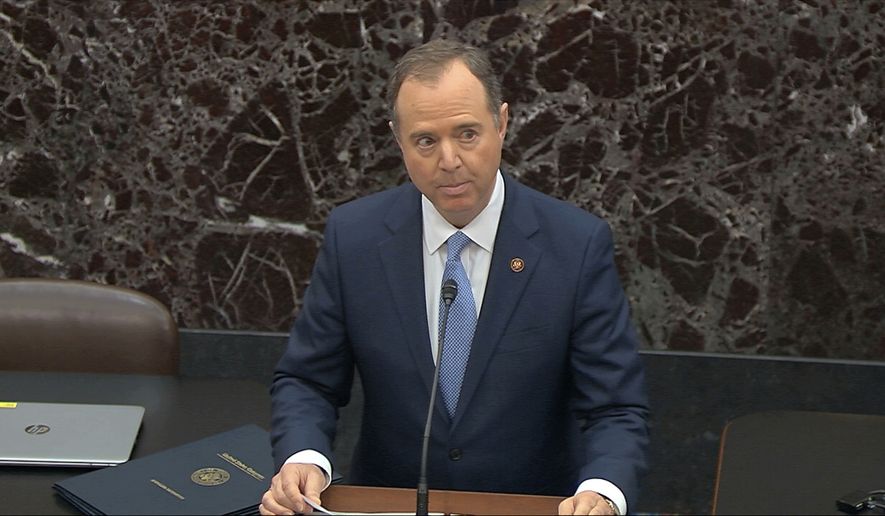Rep. Adam Schiff, the lead House impeachment manager, read aloud Thursday the articles of impeachment against President Trump as the senators all sat quietly in their seats, a formality that officially kicked off the process in the upper chamber.
The presentation began around noon and the senators, who will serve as jurors, will be sworn in later Thursday.
As House Intelligence Committee chairman, Mr. Schiff led the impeachment inquiry into Mr. Trump, telling the senators the president “demonstrated he will remain a threat to national security and the constitution if he is allowed to remain in office.”
Under the Senate rules, the reading of the articles now usurps the chamber’s floor time, so the focus will remain on Mr. Trump’s impeachment trial, which will begin Tuesday.
White House counselor Kellyanne Conway said the shift to the Senate “means that the White House, finally, on behalf of the president of the United States, can present its case under oath and in a full and fair trial.”
She said Mr. Trump “wants a full and fair process.”
“It doesn’t matter if it’s short or long, protracted or quick, it matters that it’s full and fair, because it was neither in the House proceeding,” Mrs. Conway said. “It’s in the Senate’s hands.”
Asked what the president wants, she said, “What he wants, he’s going to get, which is to be acquitted, and exonerated and not convicted, not removed from office, and reelected.”
She said the White House could officially name its legal team for the trial as early as Thursday. White House Counsel Pat Cipollone will be the lead attorney for the president.
She also said the impeachment case is about pure partisanship.
“Let’s stop pretending that this is about the Ukraine call,” Mrs. Conway said.
“This is about getting the president. If they [Democrats] had any faith in all those white people who are left on the Democratic debate stage running for president — wow — if they had any faith they could beat Donald Trump at the ballot box, they would put all their energy into that.”
“But instead they want to get the president now. And they can’t. He’ll be acquitted in the Senate, and he won’t be removed from office, and hey’ll be reelected,” she said.
The impeachment of Mr. Trump stems from a July 25 phone call in which he pressed Ukraine President Volodymyr Zelensky for a “favor” in investigating former Vice President Joseph R. Biden and Ukraine meddling in the 2016 election.
A whistleblower, who is believed to be a CIA official assigned to the White House, accused the president of abusing his power for personal gain on the call, including withholding $391 million of U.S. military aid from Ukraine as leverage.
The whistleblower also is believed to have ties to the Democratic Party and the elder Mr. Biden, and the whistleblower is known to have met with Mr. Schiff’s staff for guidance before making the complaint.
A rough transcript of the call the White House released in late September did not show the president present a quid pro quo deal for the investigations, but Democrats said the threat was understood and part of an ongoing pressure campaign of “shadow” foreign policy conducted by Mr. Trump’s private lawyer, former New York Mayor Rudolph W. Giuliani.
New evidence the House Democrats obtained since passing the two articles of impeachment in a party-line vote Dec. 18 detail Mr. Guiliani’s activities in Ukraine but does not significantly change what was already known.
The articles rely heavily on testimony from Gordon Sondland, the ambassador to the European Union, who said he offered a prized White House visit for the newly elected Mr. Zelensky in exchange for his announcement of the investigations. But Mr. Sondland said he “presumed” that was what Mr. Trump wanted.
In his only conversation with the president about it, Mr. Trump told him that there was “no quid pro quo,” he testified.
None of the witnesses in the impeachment inquiry linked the holdup of military assistance to the investigations or provided a reason for the holdup. The aid was delayed for about two months, before the money started to flow to Ukraine on Sept. 11, two days after the Inspector General of the Intelligence Community informed Congress of the whistleblower complaint.
Mr. Trump has acknowledged that he wanted an investigation into alleged corruption involving the Bidens and Ukraine interference in the 2016 election.
Interest increased in Mr. Biden’s actions in Ukraine after he recently boasted of forcing Ukraine to fire the country’s chief prosecutor in spring 2016. He said threatened to block a $1 billion U.S. loan guarantee. The prosecutor was widely viewed as not doing enough to combat corruption. But the prosecutor, Viktor Shokin, also had looked into corruption allegations against Burisma and Mykola Zlochevsky, the Ukraine oligarch running the company.
Mr. Trump also wanted Ukraine to look into a missing Democratic National Committee server that was hacked by Russia during the 2016 presidential campaigns. An American cybersecurity company called CrowdStrike examined the server to probe the hack but the server disappeared before it got to the FBI.
Mr. Trump subscribes to an unsubstantiated theory that the server ended up in Ukraine.
• Dave Boyer can be reached at dboyer@washingtontimes.com.
• S.A. Miller can be reached at smiller@washingtontimes.com.
• Alex Swoyer can be reached at aswoyer@washingtontimes.com.




Please read our comment policy before commenting.